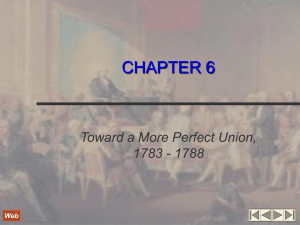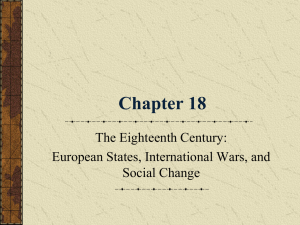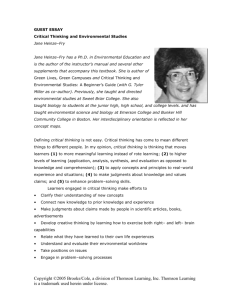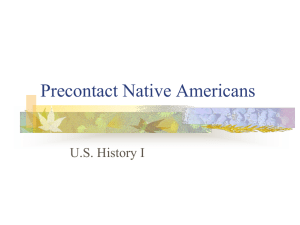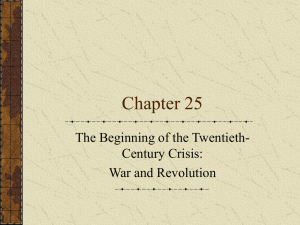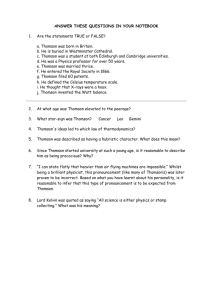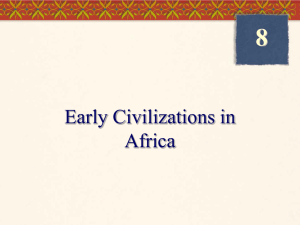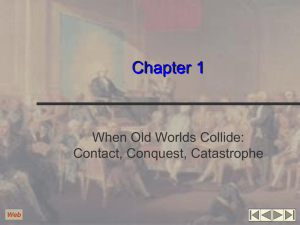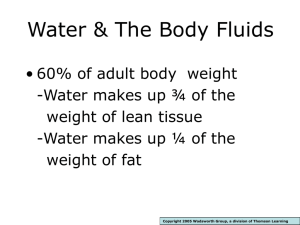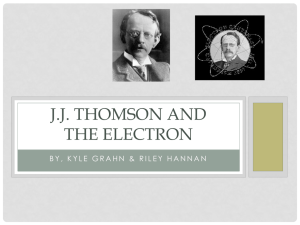Chapter 6
advertisement
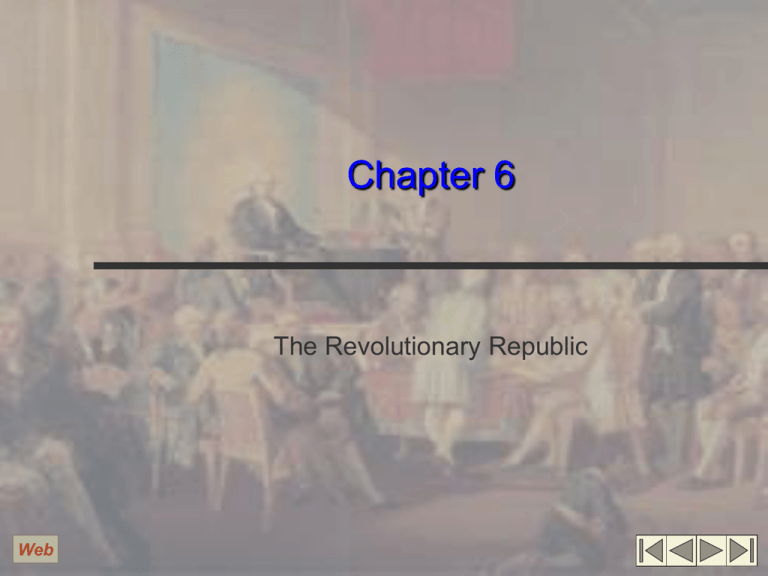
Chapter 6 The Revolutionary Republic Web Early Military Confrontations of the Revolution British determination to hold colonies escalated after Declaration of Independence Initial efforts to reach negotiated settlement not fruitful Confronted strong opposition from the Continental Army Poor morale, though, threatened the American position American victories at Trenton and Princeton in late 1776 and early 1777 Boosted American confidence Led to congressional efforts to increase and extend enlistments and create a more professional army Shattered British morale and optimism of early victory Military Campaigns of 1777 In South, British occupied Philadelphia in September Washington retreated with his troops to Valley Forge Worked on professionalizing his force In North. British took Ticonderoga in June by accomplished little thereafter Surrendered at Saratoga in October ©2004 Wadsworth, a division of Thomson Learning, Inc. Thomson Learning™ is a trademark used herein under license. Revolutionary War in the Northern States The Revolution becomes A World War French aid coming to Americans since 1776 Anxious to weaken old enemy Britain Benjamin Franklin sought treaties of assistance and recognition French decided to recognize American independence after the British defeat at Saratoga French signed two treaties with the United States in 1778 The Revolution becomes a World War (cont.) Commercial agreement granted generous trading terms for Americans in France Perpetual military alliance promising support until Americans had gained their independence Resulted in British declaration of war on France Spain’s involvement followed French treaties Never signed direct alliance with the United States Joined France in helping defeat British Sought to regain Gibraltar and stabilize its North American possessions Internal Debates in the United States over Governmental Path John Adams, Thoughts on Government (1776) Suggested government divided into executive, legislative, and judicial branches Bicameral legislature and balance of powers between branches Virginia state constitution, 1776 Influenced by Adam’s ideas All important powers vested in elected assembly Included declaration of rights protecting citizens Used as model for other state constitutions Pennsylvania state constitution, 1776 Summoned special convention to draft constitution Internal Debates in the United States over Governmental Path (cont.) Established unicameral legislature Mandated widespread suffrage In time, constitutional convention began to function as a government Imposed oaths on all citizens Led to creation of opposition force called “Republicans” Massachusetts state constitution Original draft rejected by voters in fall of 1777 Second draft written by John Adams, 1779 Included bill of rights Bicameral legislature with wide powers Ratified by voters in 1780 Articles of Confederation Establish a National Government, 1777-78 Embodied a firm commitment to state sovereignty Congress had limited power Disagreements over disposition of western lands delayed ratification Landless states did not want sates with extensive claims to retain them Ratification came only in 1781 Primacy of states did snot bode well for strength of the Confederation Government Internal Struggles in America Assumed Crisis Proportion Presence of loyalists hampered independence drive Constituted about one-sixth of white population Number under arms exceeded number of patriots by 2 to 1 Slaves routinely backed Britain over the United States About 10 percent of slaves fled their owners during the war 20,000 slaves left with the British after the war War created large number of white refugees 60,000 to 70,000 left for other parts of the British Empire Woodland Indians, initially neutral, came to side with Britain Army morale at dangerously low levels by 1779-80 British Southern Military Strategy after 1778 After capturing Savannah, plan was to conquer all of Deep South Brutalization of civilians mobilized population against loyalists British conquered the Carolinas in mid 1780 Strong Continental resistance, though, prevented complete surrender By July 178, British held only Savannah and Charleston Virginia became last major battleground of Revolution British surrender at Yorktown in October 1781 British withdrew from Savannah and Charleston to New York British government collapsed in March 1782 ©2004 Wadsworth, a division of Thomson Learning, Inc. Thomson Learning™ is a trademark used herein under license. War in the Lower South, 1780-1781 ©2004 Wadsworth, a division of Thomson Learning, Inc. Thomson Learning™ is a trademark used herein under license. Virginia and Yorktown Campaign Peace Treaty, 1782-83 Americans conducted secret negotiations with British in Paris U.S. negotiators secured large concessions from British Mississippi lands western boundary of United States New England retained access to New Foundland fisheries Settled question of prewar debts and confiscated loyalist property French not notified of negotiations, but could do nothing to prevent them Offered way out of sticky alliance with Spain, which had not regained Gibraltar Native Americans not involved, though their land was once again being transferred American Life after Independence Religious life transformed Virginia’s Statute for Religious Freedom, 1786 Paved way for religious toleration throughout the country Increasing acceptance of Jews and Catholics War’s effect on slavery North became increasingly abolitionist Pennsylvania in 1780 passed world’s first gradual emancipation statute Followed eventually by other northern states Mixed developments in south Maryland and Virginia passed individual manumission laws Only Georgia and South Carolina engaged in Atlantic slave trade after Revolution – Finally ended by Congress in 1808 American Life After Independence (cont.) Challenges to patriarchal orientation of society War allowed women to assume greater control of everyday lives Changing nature of marriage and relationships with children Emergence of concept of “republican motherhood” gave women moral superiority in society Settling Western Land Questions Westward expansion had continued during the Revolution Kentucky and Tennessee attracted significant settlement by 1790 Britain refused to surrender western lands to recruits during the Revolution Land Ordinance, 1785 Authorized survey pf Northwest Territory and its division into townships 6 miles square Laid out plans for sale of land at public auction Northwest Ordinance, 1787 Organized settlement and land speculation already under way Territory would be divided into between 2 and 5 states Set stops by which new territories would become states Provided for public support for education and outlawed slavery ©2004 Wadsworth, a division of Thomson Learning, Inc. Thomson Learning ™ is a trademark used herein under license. Western Land Claims during the Revolution ©2004 Wadsworth, a division of Thomson Learning, Inc. Thomson Learning ™ is a trademark used herein under license. Advance of Settlement to 1790 Confederation Faced Serious Problems after the Revolution Too weak to regulate commerce or stabilize economy Shay’s Rebellion, 1787 Began in Massachusetts as opposition to tax increases Suppressed only by a volunteer force Generated calls for stronger central government Unrest in other states developed as well, especially among debtors Foreign relations also problematic Treaty with Spain in 1786 split North against South Fears that sectional differences would destroy the Union By 1786, plans afoot to form a stronger national union Constitutional Convention, 1787 Plan for multi-branch government with clear separation of powers Debate over relative power in legislature of big and small states Virginia (large state) plan Bicameral legislature with representation of both houses based on state populations New Jersey (small state) plan Each state would have same representation in legislature regardless of population Constitutional Convention, 1787 (cont.) Connecticut Compromise Proportional representation in one house, equal in the other Three-fifths compromise on how slaves would be counted for apportioning representatives and deciding taxes Federalists sought to win ratification The Federalist by John Jay, James Madison, and Alexander Hamilton made case for Constitution in 85 essays Promised inclusion of bill of rights once ratification had been accomplished Able to defeat Anti-Federalist opposition throughout country Majority of states ratified by 1789;last to hold out ratified in 1790 Web
